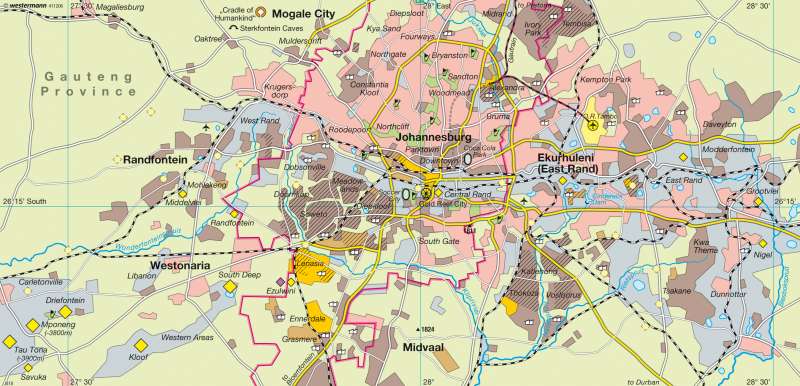Johannesburg (South Africa) — Gold mining belt Witwatersrand
Africa - Economy
978-3-14-100790-9 | Page 161 | Ill. 3

Information
The map gives an overview of the ethnic, social and economic differentiation in the Witwatersrand Region, with the metropolis of Johannesburg at its heart. The region is at the centre of South African gold mining, which has permanently marked the man-made landscape with its many spoil heaps and pits. The sites of gold mining operations divide the region into preferred residential districts in the north and districts to the south that are less desirable on account of unfavourable winds. Increasing world gold prices have led to the reactivation of sites that were partly lying idle, and in particular their prominent spoil heaps.City of Contrasts
The Witwatersrand area is the most important region of South Africa in economic terms. It includes Greater Johannesburg with West and East Rand. In recent times these latter names have frequently been Africanized in order to underline — also in semantic terms — the break from South Africa"s colonial European-dominated culture. In the north, Johannesburg will merge in the near future with Pretoria, 50 kilometres distant, via the so-called Midrand. Together the two cities will form a new megalopolis in Southern Africa with up to 9 million inhabitants.
Johannesburg/Pretoria is the only urban region in Africa of continental significance. For this reason among others, Johannesburg attracts migrants from all parts of Africa. Its central facilities are concentrated not only in the Sandton district, but also more recently again in the central Downtown district, which has been subject to many revitalization and security measures following losses of both population and image at the end of the 1990s. At the same time the O. R. Tambo International Airport, formerly Jan Smuts Airport, has developed into one of the most important traffic hubs in Africa. It is currently being fitted out for the demands of the 2010 Football World Cup.
Social Segregation
Witwatersrand remains the core region of South African industry, and Johannesburg is a service centre of global significance. In comparison to other South African provinces its unemployment level of some 30 percent is relatively low, but unemployment is distributed very unevenly throughout the region. Southern Johannesburg in particular, with its high proportion of black population in districts such as Soweto, has a much higher level of unemployment. In addition the proportion of richer income groups is lower here than in northern Johannesburg which has a larger share of white population.
The data on the map is based on the results of recent censuses in 1996 and 2001. Although carried out after the abolition of the Population Registration Act of 1950 — which required every individual to be allocated to a particular "race" — these still asked questions about ethnic group membership, but now on a voluntary basis. Even after the abolition of apartheid, skin colour remains a decisive criterion, to prevent the continued exclusion of "traditionally disadvantaged groups" and instead to further these more strongly by means of quotas and similar measures. In actual fact, even today the majority of Johannesburg"s population lives in districts that are finely separated from one another according to ethnic criteria; these also include the so-called "gated communities". Thus some authors now speak of a trend towards neo-apartheid — now based on social criteria.
U. Jürgens; Ü: J. Attfield




